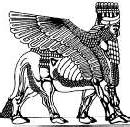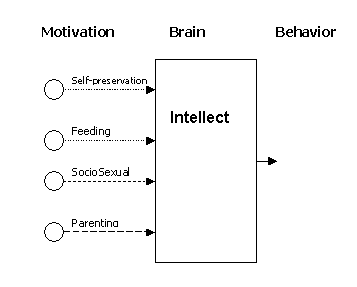
Animal Drives in Humans; A Cybernetic Model of Normal Human Behavior, ISBN 0-9694181-0-8, Trycode, Windsor, ON, Canada 1990.
Ross-Ashby was a cyberneticist, in
1960 he described the Homeostat: A multi-element dynamic model of control of body parameters. This book draws parallels between animal motivation and the elements of Ashby's Homeostat.
Living beings reduce variety
Living organisms regulate their bodies within the environment, regulation in cybernetics implies reduction of variety: A living being observes many potential stimuli and reduces the variety down to a unitary behavior. The interpretation of behavior is the vision of variety reduction. An observer sees behavior and explains it down to a deeper level of fewer variety than its cognitive appearance. Interpretation levels have different counts of variety. Depending on the context, cultural causes of human behavior probably has more variety than types of emotions, and basic animal motivations or drives has the fewest.
Black boxes don't tell what's inside!
We separate between classes intuitively by contrasting quality, like comparing the taste of apples and oranges. Traditional approaches to scientific data analysis, such as factor analysis, follow the same intuition in seeking independent factors and builds a black box model of behavior, where the factors sought after are independent of each other and do not need to correspond to any structure other than straight through paths that do not cross each other. Quality comparisons emphasize differences, quantities measure similarities and in order to obtaining structure information we need to seek quantity differences.
Dynamic systems have speed constants
Most models of personality are made of static dimensions and do not show change over time. Cybernetics studies the change over time of dynamic systems. A cybernetic system such as Ashby's Homeostat is made of coupled dynamic control elements, each element has a time constant describing the speed of its change, the shorter the speed the quicker the control and the more likely it will cause instability in the system, or in the words of Ross-Ashby "when a whole system is composed of a number of sub-systems, the one that tends to dominate is the one that is least stable". The system itself has its own time constant and if the number of elements is small then it may be possible to identify one whose constant value represents a kind of average and comes close to that of the system, the effect of the coupling between the elements influence the system's constant, the higher the coupling the slower the speed constant. If a real system could be represented by a model like Ashby's then it would be possible to understand the way the dominant and representative elements behave.
Interpretation is measurement
Human beings understand each other through language, but language alone is often not enough to carry the full meaning, sometimes people need to know the context of speech. I suggest that context is defined by the motivation of the individual and in order to identify which motivation we need to interpret the language or the behavior of the individual. I suggest that interpretation is a process of measurement, similar to an electronic device when measuring physical quantities and requires definitions of validity/reliability with respect to the motivational classifications it is referencing.
Which motivations?
Animal behavior researchers counted over one thousand possible models of motivation, selecting the most suitable in order to use in interpretation referencing is no trivial matter. Many models depend on qualitative distinctions and arbitrary criteria, here we have to seek quatitative differences, the existence of which suggests structure.
Quantity differences by themselves don't show structure but the ordering could tell if a group of measures constitutes part of a system. After reviewing many models I was influenced by the approach of Konrad Lorenz who saw animal motivations as four groups of drives: Aggression, self-preservation, feeding and reproduction. His vision provided justification for associating different speeds with different groups. One aspect of Lorenz's vision obviously did not fit: He saw aggression as a separate distinct drive, I saw that aggression is not independent but came in the context of other drives. If insecurity (aggression and fear) did not come in the context of self-preservation, feeding or reproduction then its purpose would be irrational and non-functional.
Extending Lorenz's animal ideas to humans, I observed a significant difference between humans and other animals regarding reproduction; mating is highly efficient in leading to conception in animals, on the other hand rearing children to adulthood takes much longer in humans, these observations which translate into different speeds lead me to conclude that reproduction should be split into parenting and sociosexual drives in humans, where parenting is the slowest group.
Voila!
Lets assume that each group of drives can be represented as a single source of information,the speed of recovery of a source is the average time the drives take to transition from a state of satiation to hunger in normal environment, its inverse is proportional to the frequency of action and consequently to the information content according to information theory, the faster the source the more information is emitted and the more requisite variety to transmit through a transmission line. We can stack up the sources in decreasing speeds and information content as: self-preservation, feeding, sociosexual and parenting. Lets assume that all drive information is transmitted through the brain and gets similar processing as in the diagram below.

Fig. B2.1 Sketch of uncorrelated drive sources.
I postulated that:
1- The dominant source is self-preservation which shows itself most often in behavior, the representative source is sociosexual which gives the overall direction of human behavior.
2- A possible definition of character strength could be related to coupling between the drives, the stronger the coupling the stronger the character and the more the overall direction is in line with sociosexual drives.
3- I suggested that the physiological decline in the brain's connectivity due to aging causes a reduction in its capacity to transmit data, or in cybernetics terms leads to a reduction in its requisite variety. A decline in capacity reduces the available variety of faster drives more severely, leaving the variety of the slowest drives (sociosexual and parenting) somewhat unaffected over age, therefore increasing relative dominance over faster drives.
Notice that the application of information theory when comparing speeds is strictly relative, not reference is made to the absolute sense definition. And that the simple ladder structure reflects the black box approach where all sources are considered uncorrelated. In later work I suggested that self-preservation drives, which were renamed the Emotions, correspond to priming drives in animals and act as the front end in obscuring the remaining homeostatic drives.
Are humans rational?
Since childhood I was convinced that human behavior is short-term motivated at all stages of life, which goes against the notion of cold, calculating, logical long-term rationality distinguishing humans from animals and associated with the human ability to use language.
I mentioned the story of the old man who plants palm trees in order to feed younger generations after he is dead. Some people rationalize this behavior and see it as the wisdom of age, I saw it as an expression of motivation changing with age. Age reduces the brain's capacity to process information and cuts down more severely on the requisite variety of the faster drives, feeding and sociosexual, than on parenting.
A new example of the motivational change with age: A popular New Zealand bunjee jump site offered free jumps to those of age 60 or more, there was hardly any takers. If humans were truly rational then older people with their shortened life expectancy would seek the pleasures of life more vigorously than the young.
I suggested that rationality cannot stand without motivational context, or rationality without context is irrational! And it is motivation, not rationality or the logic of language, which influences our behavior the most.
What the book didn't say
The book Animal Drives in Humans was published in 1990, before I investigated the possible structure of the model of drives, and before applying the mathematics of nonlinear systems analysis. The structure and analysis were published in a joint paper in peer-reviwed academic journal in 1995. The structure identifies self-preservation drives as priming mechanisms and the rest as homeostatic, the different mechanisms allow the age predictions to be modified somewhat: Priming is relatively constant with age while feeding, sociosexual and parenting drives are falling, peaking and rising respectively.





